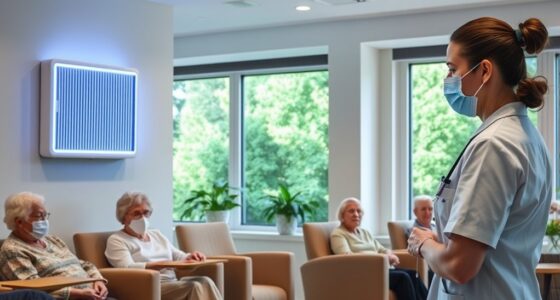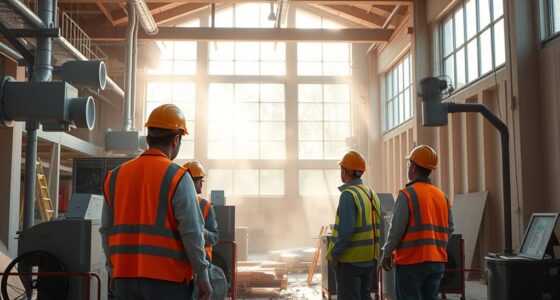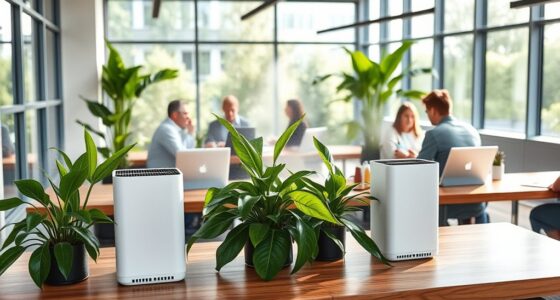To improve IAQ in sports arenas and stadiums, focus on optimizing ventilation systems that effectively circulate fresh air and reduce pollutants like CO₂, dust, and allergens. Incorporate high-quality filters, such as HEPA, and maintain them regularly. Using additional technologies like UV-C lights or ionizers can further neutralize airborne pathogens. Proper airflow management and pollutant control keep the environment healthier and more comfortable. Keep exploring to learn how these strategies can help you create a safer, cleaner space for everyone.
Key Takeaways
- Implement properly designed HVAC systems with adequate ventilation rates to dilute indoor pollutants effectively.
- Use high-efficiency air filters like HEPA to capture dust, pollen, bacteria, and airborne particles.
- Incorporate demand-controlled ventilation to adjust airflow based on real-time occupancy levels.
- Integrate air purification technologies such as UV-C lights and ionizers to neutralize viruses and bacteria.
- Regularly maintain and clean ventilation, filtration, and air purification systems to ensure optimal IAQ performance.

Indoor air quality (IAQ) is essential in sports arenas and stadiums because large crowds and high activity levels can quickly lead to poor ventilation and increased pollution. When thousands of spectators gather, their breathing, combined with activities like cheering and movement, releases carbon dioxide, dust, and other pollutants into the air. To maintain a healthy environment, you need to focus on optimizing ventilation efficiency. Effective ventilation ensures that fresh air circulates throughout the space, diluting indoor pollutants and reducing the buildup of contaminants. Without this, the air can become stuffy, and the concentration of airborne pathogens or allergens can rise, risking the health and comfort of everyone inside.
Proper ventilation and air quality are vital for health and comfort in crowded sports venues.
You can improve ventilation efficiency by designing and maintaining a robust HVAC system tailored to the arena’s size and occupancy levels. Properly balanced air exchange rates are critical; too little fresh air can cause stagnation, while excessive ventilation might waste energy and increase operational costs. Regular maintenance of ventilation equipment is essential to keep airflow at its best. This includes inspecting fans, ducts, and vents to prevent blockages or leaks that could hinder air movement. You should also consider installing demand-controlled ventilation systems that adjust airflow based on real-time occupancy levels, ensuring the arena receives enough fresh air without unnecessary energy expenditure.
Air filtration plays a pivotal role alongside ventilation in maintaining IAQ. High-quality air filters capture dust, pollen, bacteria, and other airborne particles before they circulate through the space. Upgrading to HEPA filters or other advanced filtration systems can markedly lower the presence of pollutants and allergens, especially during peak usage times. You should also ensure that filters are replaced or cleaned regularly, following manufacturer guidelines, to prevent clogging and maintain their effectiveness. Enhanced air filtration not only improves IAQ but also reduces the spread of airborne illnesses, which is especially important in crowded environments like stadiums.
In addition, integrating air purification technologies such as UV-C lights or ionizers can further enhance air quality by neutralizing viruses and bacteria. Incorporating advanced filtration systems with proper ventilation strategies creates a multi-layered approach to ventilation efficiency and air filtration, which is essential in high-density venues. By prioritizing these strategies, you guarantee a safer, healthier environment for spectators, staff, and athletes alike. Good IAQ isn’t just about comfort; it’s about protecting everyone’s health while maintaining the overall integrity of your sports arena or stadium.
Frequently Asked Questions
How Does IAQ Affect Athlete Performance?
Poor air quality can greatly impact your athletic performance by reducing oxygen intake and causing fatigue. When indoor air quality standards aren’t met, athletes may experience decreased stamina and concentration, risking injury and health issues. Maintaining good IAQ supports athlete health, enhances focus, and boosts performance. You should prioritize proper ventilation and air filtration to guarantee ideal conditions, helping you perform at your best during every game or workout.
What Are the Best Air Purification Technologies for Stadiums?
They say, “Prevention is better than cure,” so choosing the right air purification technology is key. For stadium ventilation, high-efficiency particulate air (HEPA) filters, UV-C light, and ionizers are your best options. These systems effectively remove pollutants and pathogens, ensuring fresh air. Implementing advanced air purification in your stadium creates a healthier environment, boosts fan experience, and maintains safety during large events.
How Often Should IAQ Be Monitored During Events?
During events, you should conduct air sampling regularly, ideally every 2 to 4 hours, to monitor contamination levels effectively. This helps you identify any spikes in pollutants or airborne contaminants early. By frequently checking contamination levels, you can promptly address ventilation issues or air quality concerns, ensuring a safe environment for all attendees. Consistent monitoring allows you to maintain the most suitable air quality throughout the event.
What Indoor Plants Improve IAQ in Sports Venues?
Did you know indoor greenery can reduce airborne pollutants by up to 30%? You should consider plants like spider plants, snake plants, and pothos, as they excel at air filtering. These indoor plants improve IAQ by absorbing toxins and increasing oxygen levels, creating a healthier environment for spectators and staff alike. Incorporating such greenery into your sports venue not only boosts air quality but also enhances overall ambiance.
How Do Ventilation Systems Impact Crowd Safety and Comfort?
You see, proper ventilation design and airflow optimization are essential for crowd safety and comfort. They help remove pollutants, control temperature, and reduce airborne pathogens, ensuring fresh air circulates effectively. When you prioritize these aspects, you minimize the risk of stuffiness or overheating, making the environment more comfortable. Good ventilation also detects and addresses potential issues quickly, creating a safer, more enjoyable experience for everyone in the arena or stadium.
Conclusion
Ensuring good IAQ in sports arenas and stadiums is vital for the health and comfort of everyone. Did you know that poor indoor air quality can reduce athletic performance by up to 15%? By investing in proper ventilation and air purification, you create a safer environment for fans and athletes alike. Prioritizing IAQ not only boosts overall experience but also helps prevent airborne illnesses, making your venue a healthier, more inviting place for all attendees.









